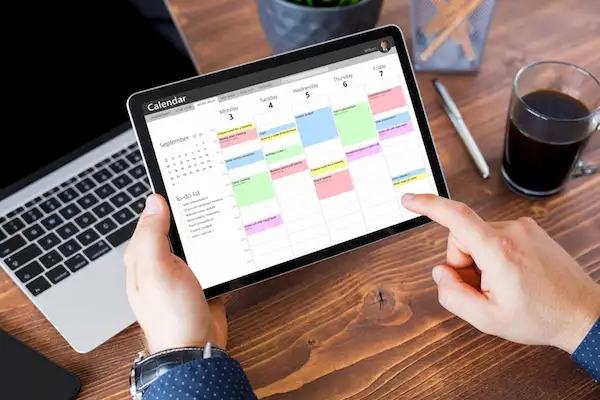Organizing your digital space is very important. With the amount of time we spend in front of phone screens, computer monitors, and other digital interfaces today, it’s no surprise that our virtual spaces are almost as critical for our well-being as our physical ones are. A chaotic inbox can inspire stress, while a clean and organized one can provide you with a surprising level of serenity. We know which one we’d prefer — so how can one get to this exalted level of digital organization?
You don’t have to be a 21st-century Bodhisattva to find peace amid the digital chaos. A smart and proactive approach to organizing your data will take you farther than another mindfulness exercise (although to be fair, that might not hurt either). Here are seven ways you can take control of your digital space and make it a cleaner, nicer, and saner place to be.
Tips for Organizing Your Digital Space
1. Set Up Your Inbox for Success.
The email inbox is one of the most stressful digital spaces for many people since it’s often overwhelmed by a constant stream of communications ranging from urgent to useless. By setting up your inbox to automatically filter these emails and put them where you want them, you can take away some of the pressure that comes with the daily email avalanche and make sure you don’t miss emails that really do need your attention. Gmail offers robust options for automatically filtering and categorizing emails, as well as adding custom labels, marking important contacts, and other useful tricks.
2. Use a Password Manager.
Secure and orderly access to your accounts is one of the most important aspects of your digital space, and a password manager will help you get there. Password manager software stores all of your passwords in an encrypted digital vault. Not only are password managers much harder for hackers to crack than a Word document is, but they also make it easy to share all of your passwords across your laptop, phone, and other devices. Tons of different password managers are on the market today, and most offer options such as family and business plans that can connect shared accounts between multiple users.
3. Organize Your Bookmarks into Folders.
Browser bookmarks are a useful tool, but they can quickly get messy without an organizational scheme. Take advantage of the bookmark folder systems that just about every browser now offers, and remember that most browsers also allow you to import bookmarks from a different profile or browser. For those who rely on bookmarks as part of their everyday workflows, a bookmark manager extension can be a useful tool. It’s also a good idea to prune your bookmarks regularly since what you had bookmarked six months ago may no longer be relevant.
4. Separate Your Work and Personal Accounts as much as You Can.
There are plenty of good reasons to keep your work and personal accounts on separate devices. One that’s often overlooked, however, is that it’s much easier to keep things organized and focused! The spillover of work and personal accounts makes it easy to waste time on Instagram at work, to get stressed out by work emails on the weekend, or (oops) to upload something personal to the company’s cloud storage. If crossing over certain accounts is unavoidable, try using automatic scheduling features to set up times when they won’t bother you. Slack, for example, allows you to turn on Do Not Disturb mode on weekends automatically.
5. Use Digital Wallet Apps to Keep All of Your Payment Methods Organized and Secure.
Many of us pay for things online as often as (or more than) we pay for them in person. So why not keep your payment methods in a convenient digital format? That’s the idea behind the many digital wallet apps now on the market, which can keep digitized versions of all your favorite payment methods in one secure app. You’ll never have to go hunting for that credit card expiration date again! Apple Wallet is the most popular and visible of the digital wallet apps, but it’s far from the only one, so poke around and find one that provides features you like.
6. Group Your Apps into Folders to Make them Easier to Find.
Is your phone screen overflowing with so many apps that it’s hard to find what you’re looking for? App folders are your friend! People use them in many different ways. Some folks prefer to have all of their finance apps in one folder and all of their travel apps in another, while other people group apps alphabetically or even by the color of the app icon. In fact, if you use an iPhone or iPad, iOS will automatically categorize your apps for you through App Library, although this feature, unfortunately, doesn’t allow you to change the groupings.
7. Keep Your Files Organized with Tags.
Both Windows and macOS include easy options for adding tags to files. Tags allow you to easily categorize files and see all of the relevant materials by project, client, or another relevant factor. What’s more, they’re easy to apply. In most cases, you can tag a file through the right-click menu in Finder or File Explorer. (For best results, tag files as soon as you download or create them.) Once you’ve tagged your most important files, you’ll be able to search, browse, edit, and transfer them in groups — a huge potential time-saver when you’ve got many important files on your device.
Your digital space can be as productive as you make it! Regularly investing a little time in straightening things up on your phone and computer will pay off later when you’ve got everything you need at your fingertips. Of course, as any Zen master will tell you, change is a constant — so perhaps the most important tip of all is to stay flexible and remain curious about the new organizational tools that are constantly entering the market.
- SEO Powered Content & PR Distribution. Get Amplified Today.
- Platoblockchain. Web3 Metaverse Intelligence. Knowledge Amplified. Access Here.
- Source: https://iotworm.com/tips-for-organizing-your-digital-space/






